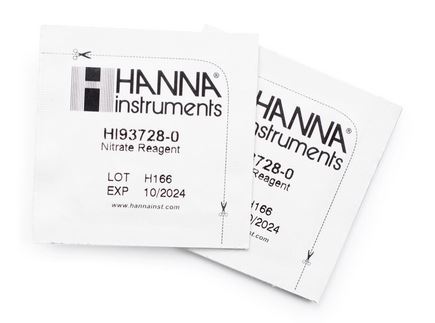NITRATE REAGENT (HI 93728-0) box 100 bags
Valid Article
NITRATE REAGENT (HI 93728-0) box 100 bags
Form
Pack of reagents for the colorimetric determination of nitrate as nitrogen.
Marked with the lot number and expiry date on each packet for traceability.
Closed article:Hanna Instrument, with manufacturer reference HI 93728-0.
Per box of 100 tests.
Fit
Consumable for CWATTESTIN- PORTABLE PHOTOMETER nitrate (HI 96786C) set
Function
Reagents that are pre-measured, for colorimetric measurements.
The method is an adaptation of the cadmium reduction method in which the reaction between nitrate and the reagent causes an amber tint in the sample.
The intensity of colour is determined by a compatible photometer
The nitrate concentration will be displayed in mg/L (ppm) as nitrate-nitrogen (NO3--N). These reagents are designed to be used with samples that have an expected range of 0.0 to 30.0 mg/L (ppm) nitrate-nitrogen.
Tip for an accurate measurement
It is important that the sample does not contain any debris.
When the cuvette is placed into the measurement cell, it must be dry outside and completely free of fingerprints, oil or dirt. Wipe it thoroughly with HI-731318 or a lint-free cloth prior to insertion.
Shaking the cuvette can generate bubbles, causing higher readings. To obtain accurate measurements, remove such bubbles by swirling or by gently tapping the cuvette.
Do not let the reacted sample stand for too long after reagent is added, or accuracy will be lost.
After the reading, it is important to discard the sample immediately, otherwise the glass might become permanently stained.
Nitrates are normally present in natural, drinking and waste waters. Nitrates enter water supplies from the breakdown of natural vegetation, the use of chemical fertilisers in modern agriculture and from the oxidation of nitrogen compounds in sewage effluents and industrial wastes. Nitrate is an important control test for water supplies. Drinking waters containing excessive amounts of nitrates can cause methaemoglobinaemia in bottle-fed infants (blue babies).


![[CWATTESTIN-] PORTABLE PHOTOMETER nitrate (HI 96786C) set](/web/image/product.template/558010/image_256/%5BCWATTESTIN-%5D%20PORTABLE%20PHOTOMETER%20nitrate%20%28HI%2096786C%29%20set?unique=5dc8c62)